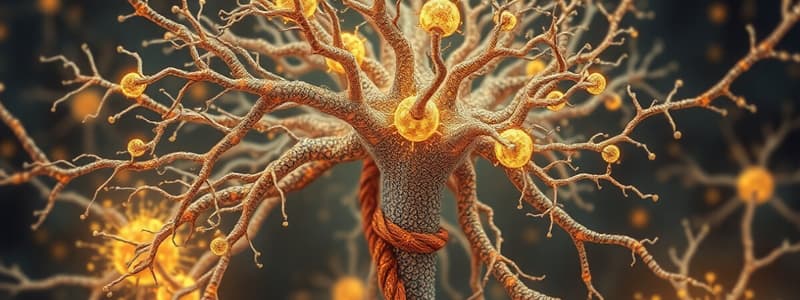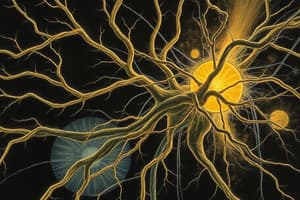Podcast
Questions and Answers
What is the primary function of oligodendrocytes in the central nervous system (CNS)?
What is the primary function of oligodendrocytes in the central nervous system (CNS)?
- Myelinate axons (correct)
- Generate action potentials
- Produce cerebrospinal fluid
- Act as immune cells
Astrocytes help maintain the blood-brain barrier.
Astrocytes help maintain the blood-brain barrier.
True (A)
What is the main role of cerebrospinal fluid (CSF)?
What is the main role of cerebrospinal fluid (CSF)?
Provides nutrients to neurons and protects the brain.
The ________ cells in the peripheral nervous system (PNS) are responsible for myelination.
The ________ cells in the peripheral nervous system (PNS) are responsible for myelination.
Which neuron type is typically involved in sensory transmission from the inner ear?
Which neuron type is typically involved in sensory transmission from the inner ear?
Match the following glial cells with their functions:
Match the following glial cells with their functions:
Chemical synapses are faster than electrical synapses.
Chemical synapses are faster than electrical synapses.
What are the three connective tissue layers surrounding nerves?
What are the three connective tissue layers surrounding nerves?
What is the primary role of Schwann cells in the peripheral nervous system?
What is the primary role of Schwann cells in the peripheral nervous system?
Afferent neurons carry signals from the brain to the effectors.
Afferent neurons carry signals from the brain to the effectors.
What is the function of microglia in the brain?
What is the function of microglia in the brain?
The ________ produces and circulates cerebrospinal fluid (CSF).
The ________ produces and circulates cerebrospinal fluid (CSF).
Match the following neurotransmitters with their characteristics:
Match the following neurotransmitters with their characteristics:
What structure generates action potentials in neurons?
What structure generates action potentials in neurons?
Electrical synapses rely on the release of neurotransmitters.
Electrical synapses rely on the release of neurotransmitters.
What connective tissue layer surrounds individual axons?
What connective tissue layer surrounds individual axons?
Flashcards
Efferent Neuron
Efferent Neuron
Carries signals from the brain to muscles or glands.
Afferent Neuron
Afferent Neuron
Carries signals from the body to the brain.
Chemical Synapse
Chemical Synapse
Signal transmission between neurons using neurotransmitters.
Electrical Synapse
Electrical Synapse
Signup and view all the flashcards
Schwann Cell
Schwann Cell
Signup and view all the flashcards
Oligodendrocyte
Oligodendrocyte
Signup and view all the flashcards
Neurotransmitter Removal
Neurotransmitter Removal
Signup and view all the flashcards
Blood-Brain Barrier
Blood-Brain Barrier
Signup and view all the flashcards
Nissl Body
Nissl Body
Signup and view all the flashcards
Axon Hillock
Axon Hillock
Signup and view all the flashcards
Synaptic Cleft
Synaptic Cleft
Signup and view all the flashcards
Multipolar Neuron
Multipolar Neuron
Signup and view all the flashcards
Bipolar Neuron
Bipolar Neuron
Signup and view all the flashcards
Unipolar Neuron
Unipolar Neuron
Signup and view all the flashcards
Microtubules
Microtubules
Signup and view all the flashcards
Neurofilaments
Neurofilaments
Signup and view all the flashcards
Study Notes
Nervous System Review
- Neurons: Transmit signals, crucial elements for conductivity.
- Excitability & Conductivity: Neurons experience excitability and conductivity for signal transmission.
- Nissl bodies: Protein synthesis occurs here.
- Glial cells (oligodendrocytes): These myelinate axons in the CNS, protecting them and increasing signal speed.
- Cerebrospinal fluid (CSF): Provides protection and support for neurons.
- Axon Hillock: Generates action potentials.
- Synapses: Allow chemical signals between neurons (slower).
- Electrical synapses: Connect neurons directly (faster).
- Synaptic plasticity: Enables the nervous system to adapt and adjust synapse strengths, crucial for learning and memory.
- Schwann cells: Myelinate axons in the PNS.
- Myelin: Insulation for axons, improving signal transmission rate.
- Astrocytes: Form the blood-brain barrier, protecting the brain.
- Microglia: Immune cells in the brain, removing pathogens.
- Ependymal cells: Involved in producing and circulating cerebrospinal fluid.
- Neuron types: Multipolar (motor), bipolar (sensory), unipolar (sensory).
- Neurotransmitters: Crucial for chemical signal transmission between neurons.
- Signal Transmission: Neurons receive signals at dendrites and transmit them down the axon.
- Axonal transport: Moves materials along the axon.
- Neurotransmitter removal: Degrades and recycles NT to prevent continuous signals.
- CNS (central nervous system): Brain and spinal cord.
- PNS (peripheral nervous system): Nerves branching out to other parts of the body.
- Ganglia: Group of neuron cell bodies in the PNS.
- Neurotransmitter types: Glutamate (excitatory).
- Myelin Sheath: Coverings of axons that function in insulation to increase signal transmission speed
- Nodes of Ranvier: Gaps in the myelin sheath.
- Endoneurium, Perineurium, and Epineurium: Enclosing layers of nerves
Studying That Suits You
Use AI to generate personalized quizzes and flashcards to suit your learning preferences.




